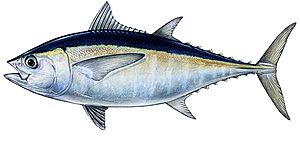Blackfin tuna facts for kids
Quick facts for kids Blackfin tuna |
|
|---|---|
 |
|
| Conservation status | |
| Scientific classification |
The blackfin tuna (Thunnus atlanticus) is a type of tuna fish. It belongs to the family called Scombridae. Sometimes people call it the Bermuda tuna or blackfinned albacore. This fish is the smallest tuna in its group, Thunnus. It usually grows up to 100 cm (39 in) long. The biggest ones can weigh around 21 kg (46 lb).
Blackfin tuna love warm, tropical waters. They live along the eastern coasts of North and South America. You can find them from Massachusetts down to Rio de Janeiro in Brazil. They also swim in the Gulf of Mexico and the Caribbean Sea.
This tuna is not as popular for selling as other tunas. These include the yellowfin, bluefin, and skipjack tuna. But it is a very popular fish for sports fishing. This is especially true in Florida and places like Cuba and the Bahamas. Blackfin tuna tastes just as good as its famous relatives. You can cook it in many of the same ways. It is also good enough to be used for sushi. People catch them by trolling or drift fishing. They also use poles with live bait or lures. These lures can be small fish, feathers, or jigs.
In 2010, the IUCN said blackfin tuna were of "least concern." This means they are not in danger of disappearing.
Contents
What Does a Blackfin Tuna Look Like?
Blackfin tuna are the smallest kind of tuna fish. The largest blackfin tuna ever caught weighed 20.6 kg (45 lb 7 oz). It was caught off the coast of Florida. Their bodies are shaped like an oval. Their backs are dark blue to black. The sides and belly are silver. This makes them look shiny in the water. They also have a yellow stripe along their side. Their scales are strong and close together. They have a mouth that slants upwards.
Blackfin tuna have small fins on their backs called dorsal finlets. These finlets are brownish with white edges. This helps tell them apart from other tunas. Other tunas often have yellow dorsal fins. These finlets connect the two large back fins to the tail. You can also tell blackfin tuna apart by their gills. They have fewer gill rakers than most other tuna species. Most tunas have at least 30 gill rakers. Blackfin tuna only have 20 to 23. Also, their liver is smooth on the bottom. Other tuna species have lines on the bottom of their liver.
How Blackfin Tuna Live and Eat
Blackfin tuna hunt for food both near the surface and in deeper waters. They eat smaller fish and squid. They also enjoy crustaceans like shrimp and crabs. Sometimes they eat tiny ocean creatures called amphipods. They catch small prey by filtering water. For bigger prey, they chase and catch them.
This fish can have many small creatures living on it. These are called parasites. There are 9 known types of parasites that live on blackfin tuna. Some of these are tiny worms or small crustaceans. Even cookiecutter sharks can attach to them.
The Life of a Blackfin Tuna
Blackfin tuna grow quickly and do not live very long. A 5-year-old blackfin tuna is considered old. They are ready to have babies when they are about 2 years old. At this age, they weigh about 4 to 6 pounds. Young tuna of all kinds look very similar. This is because their early lives are much alike. But as adults, they become quite different.
Blackfin tuna usually lay their eggs off the coast of Florida. This happens between April and November. In the Gulf of Mexico and near northern Brazil, they lay eggs from June to September. The Gulf of Mexico is a great place for them to have babies. The water conditions there are perfect for young blackfin tuna. The Mississippi River flows into the Gulf. This river brings nutrients that help the baby tuna grow.
Blackfin tuna like water that is warmer than 20 °C (68 °F). The female fish release their eggs into the water. Then the male fish fertilize them. These fertilized eggs become tiny larvae. These larvae float near the surface of the water. They can also be found deeper, up to 164 feet down.
Bigger fish often eat blackfin tuna. These include mahi-mahi and blue marlin. Even skipjack tuna will prey on them. Different kinds of sea birds also hunt blackfin tuna. Sometimes, blackfin tuna even eat smaller blackfin tuna.
Is Blackfin Tuna Sustainable?
In 2010, Greenpeace International looked at many types of seafood. They did not put blackfin tuna on their "red list." This list names seafood that is not sustainable. This means blackfin tuna are not currently overfished.


